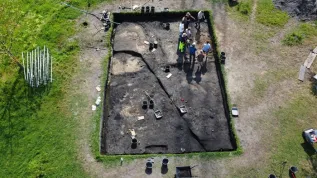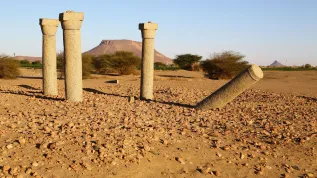
The monks of medieval Ghazali (Sudan) enjoyed high social status. Some of them came from distant regions of Africa. They were not affected by metabolic diseases related to malnutrition, because they had access to fresh fruit and vegetables, and they ate meat in quite large quantities and regularly.
This is the picture drawn by researchers from the Polish Centre of Mediterranean Archaeology of the University of Warsaw, who are exploring this site.
The archaeological site of Ghazali lies in northern Sudan, about 20 km from the modern town of Karima. It is one of two known religious complexes from medieval Nubia, located outside the Nile Valley. The monastery is located in Wadi Abu Dom, a temporarily water-filled valley that crosses the Bayuda Desert, once the busiest trade route in northeast Africa.
Researchers from the Polish Centre of Mediterranean Archaeology UW under the supervision of Dr. Artur Obłuski studied the site from 2012 to 2018. The archaeologists' work covered a medieval (7th-13th century CE) Christian monastery, as well as the remains of a small settlement, a cemetery and an iron smelting site.
In addition to excavations, scientists also used isotope tests (conducted by Dr. Joanna Ciesielska from the Faculty of Oriental Studies of the University of Warsaw together with experts from the Max Planck Institute) and DNA tests of several monks who died in Ghazali. The lead author of that research was Dr. Robert Stark.
On this basis, scientists analysed the origin, diet, and diseases of both monks and secular inhabitants of Ghazali. The last publication on the topic appeared in the Journal of African Archaeology.
According to Dr. Ciesielska, the most interesting part is the comparison of both communities: monks and the secular population of Ghazala.
The diet of monks varied much more than that of the lay secular.
'The secular population mainly consumed cheap products. Their diet was based on millet and sorghum - cheap, easy to grow cereals, resistant to climatic conditions. In the case of monks, we can observe much greater variety in the diet and a significant share of other plants: wheat, fruits, vegetables,’ Dr. Ciesielska tells PAP - Science in Poland.
Studies using nitrogen isotopes indicate that meat consumption was much higher among monks than among the locals. 'Medieval Christianity allegedly emphasised an ascetic lifestyle. It seems that monks are a group that should especially adhere to these restrictions. And it can be concluded that they ate meat n quite large quantities and regularly, not only on holidays,’ says Dr. Ciesielska.
Access to animals and their meat was not a big problem in these regions because, according to Dr. Ciesielska, large herds of cattle have always grazed on the savannahs near the Nile Valley. Goats and sheep also grazed in the Nile Valley.
However, meat was a source of wealth and animals were not slaughtered every Sunday, but rather on holidays. Only wealthy members of the community could afford to frequently eat meat products. There was probably an organized logistics system that meant that someone brought meat, vegetables and fruit to the monastery. Residents of rural areas most likely did not have access to such opportunities.
'This allows us to draw conclusions about the relatively high social status of the monks. The monasteries were well organized and had access to financial resources. The monks also had access to a wider range of food products and products that were relatively less available,’ Ciesielska says.
The scientists also analysed diseases that affected Ghazali communities. Neither population suffered from metabolic diseases related to malnutrition, which were quite common in medieval societies. Dr. Ciesielska points out, however, that the monk community has been studied much more thoroughly in this respect, so especially in the case of this population, the results indicate access to diverse and nutrient-rich food.
The monks were also much more mobile, and their backgrounds much more diverse than the secular inhabitants of Ghazali.
'Monasteries in medieval Nubia were quite popular and the most famous ones attracted people born hundreds or even thousands of kilometres away. Ghazali could have been one of such destinations for future monks,’ says Dr. Ciesielska.
DNA test results for two monks illustrate this. The research was conducted in collaboration with Dr. Robert Stark.
'The ancestors of these two monks probably came from completely different regions. One of the monks whose DNA was analysed probably came from the Arabian Peninsula, the other from central Africa,’ says Dr. Artur Obłuski, head of Polish research in Ghazali.
He adds that religious settlements exist in these areas to this day. 'A person who serves as a religious authority establishes a kind of hermitage. People start coming to the master for advice, some become his disciples. A khalwa is established - a school, in which the students live. Over time, they set up houses near the hermitage. Over recent years, we have seen akhalwa near Ghazali transforming into a settlement with several dozen houses,’ says the director of the Polish Centre of Mediterranean Archaeology UW.
Combining these two studies: of the origins of the population with information about the diet can tell a lot about the farming and lifestyle of the population. Was its economy based on agriculture or shepherding?
As for the secular population of Ghazali, they may not have been entirely sedentary. 'Isotope tests suggest that the secular inhabitants of Ghazali largely used the +desert resources+ and their diet was based on the use of farm animals that mainly fed on wild grasses of local savannahs,’ says Dr. Ciesielska.
Dr. Obłuski adds that to this day, there are communities in Africa that, depending on the conditions, can become nomadic. 'If the climatic conditions are very difficult, they increase the number of animals and move with them. If the conditions are favourable, they settle down,’ he says.
You can visit medieval monasteries in Sudan without leaving your home, via the Virtual Nubia website. The experts from the Polish Centre of Mediterranean Archaeology UW prepared 3D models of the monastic complex in Ghazali. The digitally reconstructed buildings can be 'visited' on a computer screen or using VR goggles.
PAP - Science in Poland, Ewelina Krajczyńska-Wujec
ekr/ zan/ kap/
tr. RL













